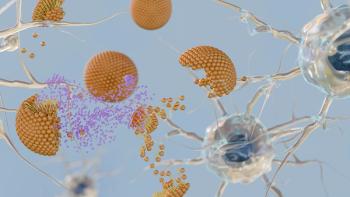
- BioPharm International June 2025
- Volume 38
- Issue 5
- Pages: 12–15
CRISPR Gene-Editing Technology in the Development of Biopharmaceuticals
Novel nucleases with diverse properties represent promising solutions, emphasizing their potential to overcome current limitations in genome editing and therapeutic delivery.
Clustered regularly interspaced short palindromic repeats (CRISPR)-associated proteins (Cas) were first described as RNA-guided nucleases in 2012, starting a new era in genome editing research. In their natural context, CRISPR-Cas systems serve as adaptive immune mechanisms protecting bacteria and archaea against invading viral genetic material. The systems are composed of two main components: a Cas nuclease, capable of introducing double-stranded breaks (DSBs) in DNA, and a single guide RNA (sgRNA), which directs the nuclease to a specific target sequence through base pairing with target DNA. Upon understanding these mechanisms, researchers adapted the CRISPR-Cas system as a programmable genome-editing tool, enabling precise induction of DSBs at any desired location within the genome. This discovery provided the rapid development of CRISPR-based applications in various fields, including biotechnology, medicine, agriculture, and fundamental research (Figure 1).
Applications
An example of the rapid evolution of CRISPR technology is the progression from its initial discovery to clinical application in just over a decade. In late 2023, the first CRISPR-based therapy was approved for the ex-vivo treatment of sickle cell disease. In addition, more than 100 CRISPR-based therapies are currently in clinical trials to treat a wide range of conditions, including blood disorders, metabolic diseases, eye diseases, and other genetic disorders (1).
Another important area of CRISPR applications in biopharmaceuticals includes disease modeling, new drug development, and cell therapies (including chimeric antigen receptor [CAR]-T cell therapy). Because many diseases are caused by genetic mutations, CRISPR technology can be used to create cell lines, organoids, or even animal models that mimic these conditions. CRISPR-mediated loss-of-function or gain-of-function screens can be employed for targeted gene identification. Using genome-wide CRISPR knockouts, CRISPR interference, or CRISPR activation, essential genes for cell survival, drug sensitivity genes, or disease-associated genes can be identified. In CRISPR screens, libraries containing diverse sgRNAs targeting a wide range of different genes or regulatory elements are packaged into lentiviral vectors (LVs). LVs are then used to transduce a large population of cells, with each cell receiving a single sgRNA. After transduction, the cells are exposed to a specific selection pressure, such as a drug, stressor, or environmental condition. Finally, next-generation sequencing is used to quantify sgRNA representation, identifying which sgRNAs became enriched or depleted, thus revealing the genes that influence the phenotype of interest. In CAR-T cell therapy, T cells can be reprogrammed to target and eliminate cells expressing these genes associated with harmful conditions. These approaches hold great promise for advancing personalized medicine.
Diversity
During the past 20 years, many CRISPR-Cas nucleases have been identified, each with unique properties that make them suitable for various genome editing applications. These nucleases differ in a wide range of characteristics, including protospacer adjacent motif (PAM) recognition site, target type (DNA or RNA), temperature preferences, size, and more (Figure 2). Some nucleases exhibit expanded targeting capabilities due to their ability to recognize distinct sequences, while others demonstrate collateral activity, making them valuable tools for nucleic acid detection in diagnostic applications. But among these properties, the size of the nuclease plays a crucial role, particularly in the context of in vivo therapeutic applications. Cas nucleases range significantly in their size, from the compact Cas12f, consisting of approximately 400 amino acids, to the much larger nucleases, such as LshCas9, which comprises more than 1500 amino acids. This size variation not only reflects their diverse functional capabilities but also directly influences their potential for practical use.
Benefits of small size
The large size of nucleases remains one of the key limitations in the therapeutic context when it comes to delivery of gene editing tools to cells and tissues. One of the most-used delivery vectors for therapeutic agents is adeno-associated viruses (AAVs). AAVs are primarily chosen for delivery due to their low immunogenicity and broad tropism—features that are essential for in vivo applications. However, AAVs have a limited packaging capacity, making it difficult to deliver nucleases exceeding 1100 amino acids, not to mention additional domains. This constraint underscores the need for smaller nucleases, which can be efficiently packaged to AAVs, enabling more effective delivery to target sites.
Compact, catalytically inactive nucleases (dCas nucleases) can be engineered by fusing them with functional domains to enable base editing, prime editing, and epigenome editing. These protein fusions—using compact nickases, such as dCas12f, dCas12l, or small dCas9 orthologs—can still fit within the limited cargo capacity of AAV vectors. Cas nickases, which introduce single-strand breaks instead of double-strand breaks, are considered safer tools for genome editing. Base editors allow precise single-nucleotide substitutions, while prime editors can introduce any substitution, as well as small insertions and deletions, within the DNA of living cells—without causing double-strand breaks. This combination of compact size and an improved safety profile makes these tools promising candidates for next-generation gene therapies.
Future perspectives
SpyCas9 is the first discovered and most studied Cas nuclease. It offers robust cleavage activity across various genome target sites, is compatible with multiple delivery systems, and works well with a range of gene-editing strategies. Its mechanism, structure, and behavior are well-understood, making it the gold standard in research and biotechnology. However, SpyCas9 is derived from the common human pathogenic bacterium Streptococcus pyogenes, which raises concerns about immunogenicity, as many individuals may already have an adaptive immune response against it. Additionally, due to its large size, SpyCas9 cannot be packaged into AAV vectors. It also recognizes the NGG PAM sequence, which limits its targeting capabilities in adenine (A)- and thymine (T)-rich genomic regions. However, a broad range of alternative nucleases (e.g., Type V CRISPR-Cas systems, including various Cas12 variants) (Figure 3) has been identified. These nucleases originate from different bacterial species, recognize distinct PAM sequences, and vary in molecular size. Consequently, ongoing research into novel and compact nucleases is essential to broaden the scope and versatility of genome-editing technologies.
This is where protein engineering plays a key role. Protein engineering involves improving the features and functions of existing proteins by manipulating their natural macromolecular architecture. Several approaches can be used, including rational design, de novo design, and directed evolution. These techniques can be applied to modify a nuclease’s PAM recognition, alter its optimal working temperature, or enhance its activity and specificity. For example, a new, compact nuclease that initially lacks cellular activity can be engineered to achieve efficient and precise DNA cleavage.
Revolutionary breakthroughs in life sciences have been driven by artificial intelligence (AI)-based applications, such as AlphaFold and protein large language models (protein LLMs). These tools enable rapid and efficient structural and functional predictions of amino acid sequences. Protein LLMs have an intrinsic ability to learn and interpret the structural composition and evolutionary significance of each amino acid in a sequence. By generating and evaluating robust predictions, these models—when combined with wet-lab methods—are driving groundbreaking innovation at an unprecedented pace.
The gene-editing field has successfully integrated these AI tools to develop more efficient and reliable technologies. Advances include reengineering CRISPR-Cas PAM recognition (3), Cas13a guide activity prediction, engineering proteins with higher editing efficiency (4), and the development of multiple off-target prediction tools.
There is no doubt that AI will be a key driver in advancing CRISPR technology, enabling the creation of more precise and effective tools. However, AI does not fully replace experimentation-based wet-lab methods, which remain essential for validation and discovery. Only when both are combined, can the use of AI in gene editing contribute to more powerful and effective tools.
Challenges
CRISPR and other gene-editing tools are changing biopharmaceutical development—starting a new generation of precision medicines for cancer, various genetic diseases, and rare disorders. CRISPR technologies give unprecedented opportunities to control the human genome, allowing the potential for therapies that until now were impossible. Smaller nucleases create significant value to the development of novel biopharmaceuticals. CRISPR variants such as Cas12 offer advantages in delivery efficiency, target specificity, and compatibility with diverse therapeutic platforms, while AI-driven design unlocks new opportunities for optimization and scalability. Their compact size enables more effective delivery via both viral and non-viral vectors, making it possible to reach previously inaccessible tissues. Just as importantly, these alternatives help democratize the gene-editing landscape by providing options beyond IP-encumbered systems like SpyCas9. However, bench-to-clinic biopharmaceuticals development is complex. These technological advances bring new challenges, from evolving regulatory frameworks and long-term safety evaluations to broader issues of social acceptance and bioethical responsibility.
One of the major obstacles in bringing next-generation biopharmaceuticals or therapies to the market is the social perception and acceptance of novel technologies such as CRISPR. Addressing public concerns, providing accurate information, and engaging in meaningful dialogue about the benefits, risks, and ethical considerations of these technologies are crucial.
Regulatory frameworks vary significantly across regions and often are not fully synchronized with the rapid development of gene-editing innovation. Developers must navigate a complex landscape of approvals, compliance, and long-term safety requirements. At the same time, bioethics comes into the frame. While therapeutic editing holds out great potential to treat or even cure a range of genetic disorders at their root cause, key bioethics questions remain, such as the long-term safety of gene editing, potential off-target effects, and the ethical boundaries of human genome modification. As the field progresses, addressing these open questions with transparency, fostering inclusive dialog, and continuous education will be critical to realizing the full promise of gene therapies.
References
- CRISPR Medicine News. CRISPR Clinical Trials. crisprmedicinenews.com/clinical-trials/ (accessed April 30, 2025).
- Urbaitis, T.; Gasiunas, G.; Young, J.K.; et al. A New Family of CRISPR-type V Nucleases with C-rich PAM Recognition. EMBO Rep. 2022 Dec 6;23(12). DOI: 10.15252/embr.202255481
- Nayfach, S.; Bhatnagar, A.; Novichkov, A.; et al. Engineering of CRISPR-Cas PAM Recognition Using Deep Learning of Vast Evolutionary Data. bioRxiv [Preprint]. 2025 Jan 6. DOI: 10.1101/2025.01.06.631536
- Marsiglia, J.; Vaalavirta, K.; Knight, E.; et al. Computationally Guided High-Throughput Engineering of an Anti-CRISPR Protein for Precise Genome Editing in Human Cells. Cell Rep Methods. 2024 Oct 21;4(10):100882. DOI: 10.1016/j.crmeth.2024.100882
About the authors
Laima Trinkūnienė, PhD candidate, is a scientist at Caszyme. Giedrius Gasiūnas, PhD, is chief scientific officer at Caszyme. Monika Paulė, PhD, is chief executive officer at Caszyme.
Article details
BioPharm International®
Vol. 38, No. 5
June 2025
Pages: 12–15
Citation
When referring to this article, please cite it as Trinkūnienė, L.; Gasiūnas, G.; and Paulė, M. CRISPR Gene-Editing Technology in the Development of Biopharmaceuticals. BioPharm International 2025 38 (5).
Articles in this issue
7 months ago
Qualifying Expertise for Quality Support7 months ago
Guidance on Quality Culture Standards7 months ago
Inspiring DevelopmentsNewsletter
Stay at the forefront of biopharmaceutical innovation—subscribe to BioPharm International for expert insights on drug development, manufacturing, compliance, and more.




